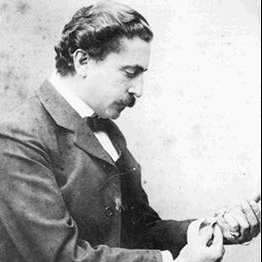Wolfers Frères

Wolfers Frères (founded 1850)
Wolfers, Louis (1820 – 1892)
Wolfers, Philippe (1858 – 1929)
Wolfers, Marcel (1886 – 1976)
The traditional Belgian house of Wolfers, a dynasty of gold- and silver smiths, is famous for its luxurious silver wares. These include the designs of the all-round genius Philippe Wolfers, whose artistic symbolism jewellery of Art Nouveau styling exhibits fantastical forms and magnificent colour schemes at a world-class level of quality.
From humble beginnings in a small arts and crafts factory in Brussels, Louis Wolfers establishes a company in 1850 that achieves fame throughout all of Europe. His son Philippe, the most colourful of the Wolfers, learns the craft and the business from his father. After finishing his studies at the art academy in Brussels, he takes over the responsibility for the company’s artistic concerns. He is a true artist, sculptor, interior architect, ivory carver, medallist and glass crafter all rolled into one. In 1873 he visits the World Expo in Vienna and is inspired by Japanese arts and crafts. Although working in the neo-Rococo style until the 1880s, he passionately dedicates himself to the new Art Nouveau movement. In 1889 he builds a villa in La Hulpe in the new style and opens his workshop there, served by a team of goldsmiths and craftsmen. His teacher, the sculptor Isidore de Rudder, encourages him to follow his artistic instincts. Philippe’s designs, material selection and execution all exhibit the highest quality. His first use of ivory is in 1893, when King Leopold II gives him free access to the material brought from the colonised Belgian Congo. Wolfers‘ development corresponds in many ways to that of René Lalique in Paris. Both employ plants and animals as motifs for their jewellery. Wolfers, however, prefers a more symmetrical and stylised approach. In selecting his motifs, he displays a penchant for symbolism, preferring snakes, bats and peacocks as well as orchids and the heads and naked bodies of women. He adores using enamel, ivory, opals and cut stones. Around 1900 he creates unique, fanciful Art Nouveau jewellery and objects that garner him a great deal of attention. He signs his pieces with ‚PW ex unique‘. His works can be dated precisely, as a handwritten list of all pieces he produced is still in existence. Until 1904 Philippe Wolfers creates a wonderful series of 109 unique pieces of jewellery. He goes to the extent of giving each piece a mysterious name, such as Orchidée ailée, (winged orchid). The Belgian’s designs are one-of-a-kind, guaranteed by the destruction of the models once a piece has been created. In 1905 Philipp Wolfers breaks with jewellery design to dedicate himself exclusively to sculpture. In the years following, son Marcel assumes more responsibility and goes on to create traditional Art Déco jewellery made of platinum and diamonds. His decorative bangles in lacquer or mother of pearl are highly regarded at the Paris Exposition. As a purveyor to the royal court of Belgium, the company of Wolfers Frères receives commissions from some of the most important European dynasties.
Wolfers Frères, gegründet 1850
Wolfers, Louis, 1820 – 1892
Wolfers, Philippe 1858 – 1929
Wolfers, Marcel 1886 – 1976
Das belgische Traditionshaus Wolfers – eine Dynastie von Gold- und Silberschmieden – ist berühmt für luxuriöse Silberwaren. Vor allem die Entwürfe des Universalgenies Philippe Wolfers, symbolistische Schmuckkunst des Art Nouveau in fantasievollen Formen und fantastischer Farbgebung, sind herausragend qualitätvolle Arbeiten von Weltrang.
Louis Wolfers gelingt es aus einem kleinen Kunstgewerbebetrieb in Brüssel ab 1850 ein Unternehmen zu entwickeln, das über Belgien hinaus in ganz Europa Bekanntheit erlangt. Sein Sohn Philippe, der schillerndste der Wolfers, lernt das Handwerk und Geschäft beim Vater und zeichnet, nach beendetem Studium an der Kunstakademie in Brüssel, für die künstlerischen Belange der Firma verantwortlich. Er ist ein wahrer Künstler, Bildhauer, Innenarchitekt, Elfenbeinschnitzer, Medailleur und Glashandwerker in einer Person. 1873 besucht er die Wiener Weltausstellung und ist begeistert vom Japanischen Kunstgewerbe. Leidenschaftlich verschreibt er sich – bis in die 1880er Jahre arbeitet er noch im Stil des Neo-Rokoko – der neuen Art Nouveau Kunstbewegung. 1889 baut er in La Hulpe eine Stadtvilla im neuen Stil und eröffnet dort seine eigene Werkstatt mit einem Team von Goldschmieden und Handwerkern. Sein Lehrer, der Bildhauer Isidore de Rudder, hält ihn an seinem künstlerischen Instinkt zu folgen. Philippes Entwürfe, die Materialauswahl und die Ausführung sind von höchster Qualität. Er setzt ab 1893 erstmals Elfenbein ein, da ihm König Leopold II. das Material aus der belgischen Kolonie Kongo kostenlos zur Verfügung stellt. Wolfers Entwicklung korrespondiert vielfach mit jener von René Lalique in Paris. Beide nutzen Pflanzen und Tiere als Motive ihrer Schmuckstücke, Wolfers setzt sie jedoch bevorzugt symmetrisch und stärker stilisiert ein. In seiner Motivwahl zeigt er eine Vorliebe für den Symbolismus, bevorzugt Schlangen, Fledermäuse und Pfauen neben Orchideen und Frauenköpfen, wie -akten. Er liebt die Verwendung von Email, Elfenbein, Opalen und geschnittenen Steinen. Um 1900 kreiert er einzigartige, fantasievolle Jugendstil-Schmuckstücke und -Objekte, für die er große Anerkennung erzielt. Er signiert seine Stücke mit „PW ex unique“. Seine Arbeiten lassen sich exakt datieren, da ein handschriftliches Verzeichnis aller gefertigten Schmuckstücke existiert. Bis 1904 schafft Philippe Wolfers eine wundervolle Serie mit 109 einzigartigen Schmuckstücken. Er geht soweit, jedem einzelnen Werk einen geheimnisvollen Namen zu geben, wie „Orchidée ailée“, „geflügelte Orchidee“. Die Entwürfe des Belgiers sind einzigartig, denn nach der Ausführung der Schmuckstücke werden die Modelle zerstört. 1905 sagt sich Philipp Wolfers von der Schmuckgestaltung los und widmet sich ausschließlich der Bildhauerei. In den nachfolgenden Jahren übernimmt Sohn Marcel mehr Verantwortung und fertigt vor allem den typischem Art Déco Schmuck in Platin mit Diamanten. Auf der Pariser Exposition finden seine dekorativen Armreifen in Lack oder Perlmutt große Beachtung. Als königlich belgischer Hoflieferant erhält die Firma Wolfers Frères von den wichtigsten europäischen Fürstenhäuser Aufträge.